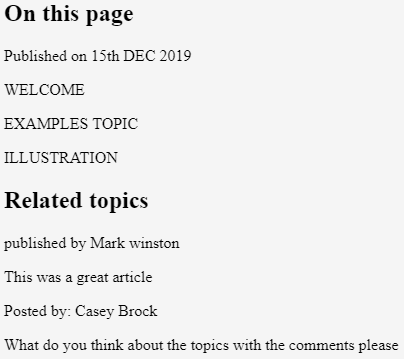Syntax:
Here let’s see the immediate syntax of these tag elements.
<article> <h1>…</h1> </article>
The structure follows the start tag. The next preceding section has
tag or that forms a sub-heading, gives exact semantic information of the content, and provides much richer and more appropriate meaningful information. Like other tags, this article tag also supports HTML attributes like event attributes and global attributes for their appropriate class.
Example of
<article> <h1>Introduction to CSS demo</h1> <p>CSS is a cascading Style Sheet helps to make a web page visually colored</p> </article>
How Does Article Tag Work in HTML?
This section will discuss a simple article tag (self-contained content in a document) and see how it works on a web page. HTML 5 introduces new semantic content to enrich the content in search engines. They do support global and event attributes for the content. The tag’s content is considered an independent document from the other content part on the single page. They can define or demonstrate an article’s name on the page, author information, and publication date. This
A document having a single article element explains the main content of the document. It has individual unique single content, whereas, in the case of multiple Below are the examples of implementing HTML Tag: Example using Single Code: Output: An example illustrates using attribute Code: The below output shows the visitors the web page with the address to the link. Output: An example Demonstrating how to display a date and time with Code: Output: Example using multiple articles. The below code uses the semantic element Code: Output: We shall see the Code: Output: Code: Here is a global header that contains web page headlines for any document with related content. Next comes the Output: Article tag with the help of Code: Output: To conclude, this article covers several guides to use on a web page. They are an excellent choice to contain a document (they sense on their own) or content in a single web page, and they are known to be a perfect semantic element under HTML5. Being a self-contained context, it has been used in html5 as cutting-edge websites have started to take full advantage of this tag is rewarded by the user well in posting content like blogs and magazines. Das obige ist der detaillierte Inhalt vonHTML-Artikel-Tag. Für weitere Informationen folgen Sie bitte anderen verwandten Artikeln auf der PHP chinesischen Website!Examples to Implement HTML Tag
Example #1
<!DOCTYPE html>
<html>
<head>
<title>HTML Article Tag demo</title> </head>
<body>
<article>
<h2>python</h2>
<p>Python is a new programming language</p>
</article>
</body>
</html>

Example #2
<!DOCTYPE html>
<head>
<title>Demo of article</title>
</head>
<body>
<article style="width: 200px; border: 1px solid black;
padding: 8px; border-radius: 8px;
margin:6px;">
<article>
<address>
Written by xxxxxx.<br>
refer me at: <br>
https://www.educba.com/ <br>
</address>
</article>

Example #3
<!DOCTYPE html>
<head>
<title>Demo of article tag</title>
</head>
<body>
<article style="width: 200px; border: 1px solid black;
padding: 8px; border-radius: 8px; color :green;
margin:6px;">
<article class="blog_post">
<p>My first article post. Stay tuned</p>
<footer>
<p>
Displayed on <time datetime="2019-12-24 20:00"> Dec 23</time> by tutor
</p>
</footer>
</article>

Example #4
to specify the most significant header within the HTML content.
<style>
.JAN {
margin: 1;
padding: .2rem;
background-color: #D2691E;
font: 2rem 'Fira Sans', sans-serif;
}
.JAN > h1,
.day {
margin: .4rem;
padding: .2rem;
font-size: 1rem;
}
.day {
background: border-box no-repeat
gray;
}
.day > h2,
.day > p {
margin: .2rem;
font-size: 1rem;
}
</style>
<article class="JAN">
<h1>FEDERAL HOLIDAYS IN USA</h1>
<article class="day">
<h2>01 JAN 2020</h2>
<p>NEW YEAR DAY.</p>
<p> martin luther day </p>
</article>
<article class="day">
<h2>18 feb 2020</h2>
<p>Presidents day.</p>
</article>
<article class="day">
<h2>05 May 2020</h2>
<h2>27 May 2020</h2>
<p>mothers day.</p>
<p>memorial day.</p>
</article>
</article>
Example #5
<style>
.art {
margin: 5;
padding: .3rem;
background-color: #DC143C;
font: 1rem 'italic', sans-serif;
}
</style>
<article class="art">
<section id="aim">
<p>[Main Objective]</p>
</section>
<section id="main_concept">
<p>[Content text]</p>
</section>
<section id="link page">
<ul>
<li><a href="tt.html">first link page</a></li>
<li><a href="th.html">second link page</a></li>
</ul>
</section>
</article>
Example #6
<article>
<header>
<h1>On this page</h1>
<p>Published on 15th DEC 2019</p>
</header>
<p>WELCOME</p>
<p> EXAMPLES TOPIC</p>
<p>ILLUSTRATION</p>
<section>
<h2>Related topics</h2>
<article>
<footer>
<p>published by Mark winston</p>
</footer>
<p>This was a great article</p>
</article>
<article>
<footer>
<p>Posted by: Casey Brock</p>
</footer>
<p>What do you think about the topics with the comments please</p>
</article>
</section>
</article>

Example #7
<!DOCTYPE html>
<head>
<title>Demo of article tag</title>
</head>
<main>
<article>
<h1>Cloud computing Basics</h1>
<p>Used for data storage.</p>
<section>
<h2>Basic and syntax part</h2>
<p>With an example.</p>
</section>
<section>
<h2>Types of cloud computing services</h2>
<p>Private , public , hybrid</p>
</section>
</article>
</main>

Conclusion


















![[Web-Frontend] Node.js-Schnellstart](https://img.php.cn/upload/course/000/000/067/662b5d34ba7c0227.png)



